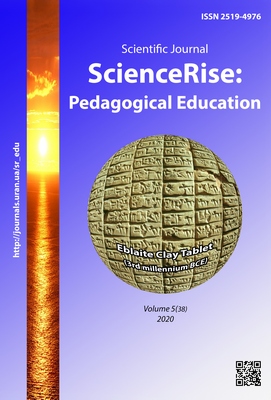Criteria and indicators for assessing the level of formation of a noble attitude towards women in adolescents
DOI:
https://doi.org/10.15587/2519-4984.2020.213388Keywords:
nobility, females, adolescents, upbringing, cognitive-behavioral, motivational-emotional, personal-reflexiveAbstract
Based on the lack of research, but the relevance of the topic of modern society, the study identifies and theoretically substantiates the criteria for the formation of a noble attitude and their respective indicators. The purpose of the study was to characterize the specific criteria and indicators of the formation of this attitude in adolescents on the basis of different approaches to the problem of the study. Based on the analysis of psychological and pedagogical literature, the concept of "criterion" was clarified, which we understand as certain features that check the formation of a noble attitude towards women and analyze the dynamics of development, and the concept of "indicator", the formation of this concept for each of the criteria. Given that moral education includes a noble attitude towards women, analyzed a number of works by scientists to determine the general level of moral education, identified the criteria and indicators that characterize the concept, namely: cognitive-behavioral (characterized by completeness and depth of knowledge about the features of manifestation of a noble attitude and application of this knowledge in practice in everyday life), volitional (characterized by the formation of motives that will motivate the individual to selfless actions in accordance with the laws of ethics and morality, and meeting the needs of the individual, as well as experiencing certain emotions and feelings to representatives of the opposite sex), the person-reflexive (includes the nature of the identification of noble qualities of personality, accompanied by a desire to become even better). The defined criteria and indicators make it possible to assess the level of formation of noble attitudes in adolescents and analyze the dynamics of their changes during the experiment. The prospect of further scientific research is to study the dynamics of changes in the level of formation of a noble attitude in accordance with certain criteria and indicators with the help of selected diagnostic tools.
References
- Kobzarenko, L. A. (2016). Vykhovannia moralno-tsinnisnykh oriientatsii studentiv pedahohichnykh koledzhiv zasobamy etnopedahohiky. Kyiv, 258.
- Stoliarenko, O. V. (2018). Teoretychni i metodychni osnovy vykhovannia tsinnisnoho stavlennia do liudyny v uchniv zahalnoosvitnoi shkoly. Vinnytsia, 610.
- Peterson, G., Hann, D.; Sussman, M. B., Steinmetz, S. K., Peterson, G. W. (Eds.) (1999). Socializing сhildren and рarents in families. Handbook of Marriageand the family. NewYork, 327–370. doi: http://doi.org/10.1007/978-1-4757-5367-7_14
- Rohner, R. (2001). Father love and child development: History and Current Evidence. The Family, 104–106.
- Melnychuka, O. S. (Ed.) (1974). Slovnyk inshomovnykh sliv. Kyiv: Holov. red. URE, 776.
- Hizhevskyi, V. K., Holovchenko, V. V., Kovalskyi, V. S. et. al. (2002). Populiarna yurydychna entsyklopediia. Kyiv: Yurinkom Inter, 528.
- Bolshoi tolkovii psikhologicheskii slovar. Vol. 1 (2001). Moscow: AST: Veche, 592.
- Kachur, M. M. (2009). Patrіotichne vikhovannia molodshikh shkoliarіv zasobami khudozhnogo kraeznavstva. Kyiv, 186.
- Zvereva, І. D., Koval, L. G., Frolov, P. D. (1995). Dіagnostika moralnoi vikhovanostі shkoliarіv. Kyiv: ІSDO, 156.
- Poiasok, T. B.; Sysoievoi, S. O. (Ed.) (2009). Systema zastosuvannia informatsiinykh tekhnolohii u profesiinii pidhotovtsi maibutnikh ekonomistiv. Kremenchuk: PP Shcherbatykh O. V., 348.
- Gaponchuk, G. I. (1990). Formirovanie voenno-pedagogicheskoi napravlennosti kursantov. Moscow: VPA, 76.
- Novyi tlumachnyi slovnyk ukrainskoi movy. Vol. 2: Zh–O (2001). Kyiv: Akonit, 911.
- Shestopaliuk, O. V. (2008). Hromadianske vykhovannia maibutnikh uchyteliv: teoretychni i metodychni elementy. Vinnytsia: Konsol, 260.
- Bozhovich, L. I. (1991). Formirovanie lichnosti v ontogeneze. Moscow, 142‒152.
- Sidanich, I. L. (2004). Vykhovannia kultury vzaiemyn batkiv i ditei molodshoho shkilnoho viku v simi i shkoli. Kyiv, 186.
- Soroka, H. I. (2002). Suchasni vykhovni systemy ta tekhnolohii. Kharkiv: Vesta; Ranok, 128.
- Staub, E. (2013). The roots of goodness: Inclusive caring, moral courage, altruism born of suffering and active bystandership. New York: Oxford University Press, 224.
Downloads
Published
How to Cite
Issue
Section
License
Copyright (c) 2020 Diana Kokhan

This work is licensed under a Creative Commons Attribution 4.0 International License.
Our journal abides by the Creative Commons CC BY copyright rights and permissions for open access journals.
Authors, who are published in this journal, agree to the following conditions:
1. The authors reserve the right to authorship of the work and pass the first publication right of this work to the journal under the terms of a Creative Commons CC BY, which allows others to freely distribute the published research with the obligatory reference to the authors of the original work and the first publication of the work in this journal.
2. The authors have the right to conclude separate supplement agreements that relate to non-exclusive work distribution in the form in which it has been published by the journal (for example, to upload the work to the online storage of the journal or publish it as part of a monograph), provided that the reference to the first publication of the work in this journal is included.








